
Information and Orders: 1-406-259-9004
Hours: Mon - Sat 10-6 MST
Central Hobbies
1401 Central Avenue
Billings, MT 59102
We Gladly Accept:

as well as

PLASTIC MODELS : ARMOR AND MILITARY VEHICLES
Shipping cost will vary by dimensions
or weight please call or email for shipping quotes.
- Page 8 of 9 | 98 Total Products
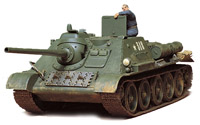
TAMIYA 1/35 Russian Su85 Plastic Model Kit
Description:
This is a model kit of the iconic SU-85 Russian tank, originally released in 1975. The real-life subject was introduced at the Battle of Kursk in 1943. The newly designed SU-85 which was based on the successful SU-122 came armed with the D-5S-85A, the 1939 anti-aircraft 51.5 caliber 85mm D-5 gun which was redesigned for anti-tank use. D-5 guns were developed in the same manner as German 88mm anti-tank guns equipped on German Tiger I and Jagdpanther tanks, as both guns were based on anti-aircraft guns. The SU-85's armor-piercing shell weighed 9.02kg, had a velocity of 792m/s, and could knock out tanks with 100mm thick armor at 1000m. The SU-85s hull featured a sloped front armor with the fighting compartment offset to the right. After the liberation of Kiev in December 1943, the SU-85 faced off Panther and Jagdtiger tanks and held its own thanks to its 85mm gun. The sharp style of the SU-85 with its long gun now comes reproduced as a 1/35 scale model. This kit was first released in 1975.
• 1/35 scale plastic model assembly kit. Length: 235mm.
• T34-design lower hull and large diameter road wheels have been realistically reproduced.
• Belt type parts recreate the tracks and their unique pattern.
• Main gun offers depression and elevation, even after assembly.
• Choose to assemble driver’s and main hatches in open or closed position.
• Comes with a figure in relaxed, seated pose.
• Includes a rich assortment of accessory parts such as fuel cans, spare track links, shovel, blankets and more!
• Decals are included to recreate different tank numbers, symbols and identification markings.

Our Price: $28.79
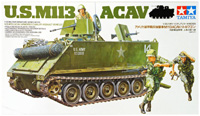
TAMIYA 135 U.S. M113 Acav Plastic Model Kit
Description:
With a cupola-come-gun shield on the M60 machine gun, the M113 ACAV (Armored Cavalry Assault Vehicle) was an improvement on its base, the M113APC (Armored Personnel Carrier). This plastic model assembly kit accurately captures the M113 ACAV, of course including the added cupola/gun shield, and also recreating the crew seats, engine and more in the interior. 3 figures in realistic pose are included in the kit.

Our Price: $28.99
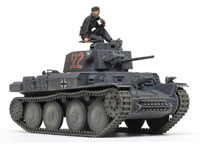
TAMIA 1/25 PANZER 38(T) AUSF.E/F PLASTIC MODEL KIT
Description:
This Tamiya 1/35 scale military miniature recreates one of Germany’s formidable lightweight tanks. This subject in fact started life as a light tank developed for Czechoslovakia, but was adopted and renamed 38(t) by German forces after their occupation of the country in 1939. It was equipped with a 3.7cm main gun and could reach speeds of up to 42km/h powered by the 125hp engine. A number of variants were produced, of which the Ausf. E/F 38(t)s were manufactured over a one-year period from November 1940; they featured improved armor and were thrown into the conflict with Soviet forces after the start of Operation Barbarossa.

Our Price: $35.99
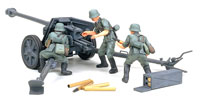
TAMIYA German 75Mm Anti Tank Gun Kit
Description:
The 7.5 cm anti-tank gun was to become the main and typical anti-tank weapon of the German Army. It was often towed by the 3-ton trator Sdkfz 11. With the progress of the war situation, the gun combined with the chassis of fighting vehicles including the Pzkpfw IV to make up a great number of tank destroyers or self-propelled anti-tank guns that rendered distinguished services thereafter.

Our Price: $7.99
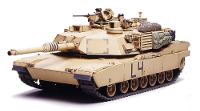
TAMIYA M1A2 Abrams Main Battle Tank
Description:
The M1 Abrams, the worlds" strongest tank, has undergone step-by-step modification since its commission by the US military in 1980. The M1A2 evolved from the M1A1HA, and features Intervehicular Information System (IVIS) and Commander"s Independent Thermal Viewer (CITV). Kit features A2 turret comes with CITV and new style vision block.
The M1 Abrams, officially commissioned by the US military in 1980, was designed totally different from previous post-WWII US military tanks. Although fitted with the same 105mm cannon as the M60, the M1 was powered by a gas turbine engine and was fitted with spaced armor. Planned to be commissioned by the US military over a long period, the M1 was designed with future reforms in mind. In 1984, the M1A1 was developed with a 120mm smooth bore cannon, and a further variant the M1A1HA was later developed featuring depleted uranium armor. This then led to the M1A2, which was fitted with Intervehicular Information System (IVIS), Commander"s Independent Thermal Viewer (CITV) turret and new style vision block. The M1A1HA and the M1A2 both played significant roles in Operation Iraqi Freedom, being deployed by land forces as well as the Marine Corps as they moved toward Baghdad.

Our Price: $55.99
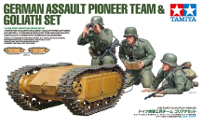
TAMIYA 1/35 German Assault Pioneer Team W/Goliath Set
Description:
This 1/35 scale model recreates the Goliath. It was a diminutive tracked vehicle about 1.5m long that could carry up to 60kg of light explosives and was remotely controlled via 3 cables that spooled out of its rear. Some 7,564 were produced in all, split between 12V battery and gas engine-powered variants. They were largely deployed by assault pioneer (Sturmpionier) units, and were hoped to give the advantage of surprise. They were used on all fronts including German counters to the allied invasions in Normandy.
• 1/35 scale plastic model assembly kit set.
• Contains parts to create 2 Goliath tracked mines. Length: 46.5mm, width: 24mm, height: 15.5mm.
• Goliaths feature assembly type tracks.
• Enamel wire is included to recreate the remote-control cable.
• Parts are included to create 3 full body assault pioneer team figures in realistic pose, with a kneeling Goliath operator, a commander surveying the battlefield and another soldier taking aim from a prone position.
• Comes with a range of accessories, recreating Karabiner 98K rifle, MP40 sub-machine gun, binoculars, P08 luger holster/magazine pouch, Goliath controller, duffel bag and water canister.
• Note: Decals are not included in this kit.

Our Price: $17.99
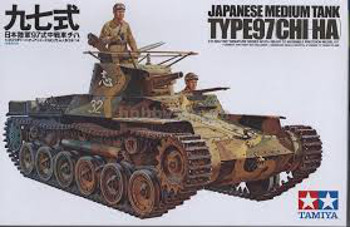
TAMIYA 1/35 Japanese Tank Type 97
Description:
This is a 1/35 Plastic Japanese Medium Tank Type 97 (CHI-HA) from Tamiya.
This Tamiya manufactured product contains two army figures.
For ages 10 and over.
Our Price: $18.49
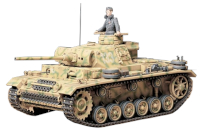
TAMIYA 1/35 German Pz. Kpfw Iii Ausf. L
Description:
The German Pz.Kpfw. III, along with the IV, played an active part in the early stages of WWII as their mainstrength tanks. However when they encountered the Russian KV and T-34 tanks on the Eastern Front, the weakness of the Pz.Kpfw.III was revealed and the balance of power tipped in favor of the Russians. Thus the pz.Kpfw. III underwent constant improvement throughout its career to maintain an advantage. The Pz.Kpfw. III had a number of types, from the A to N. Among them, the Ausf. L was produced from July 1942. As it was manufactured at the existing tank factory, the basic performance and structure were the same as previous versions with a few modifications. Armament consisted of an improved, long barreled Kwk50 L/60 tank gun, which was effective against the Russian T34 tanks up to a range of 600m, plus two 7.92mm MG34 machine guns. The armor of the front superstructure was increased to 57mm in thickness, and a 20mm thick spaced armor was added to the gun mantlet as well, which increased the tank"s weight by 200kg. To cope with the added weight, the suspension system was also strengthened. The powerplant was a Maybach HL120TRM, V-12, water cooled engine producing 300 horsepower. In total 635 Ausf. L"s were produced by the end of 1942, and many of them saw active service on the Eastern Front and the North African Front. Although its roll was shortly replaced by the Tiger I and the Panther, the durable chassis of the Pz.Kpfw. III was used for self-propelled guns till the end of the war.

Our Price: $43.99
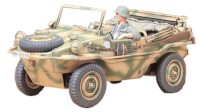
TAMIYA 1/35 Schwimmwagen Type 166
Description:
The Volkswagen Beetle, which has been called a German national car, was conceived and designed in 1938 by Dr. Ferdinand Porsche, the originator of the famous sports car manufacturer, "Porsche". The Beetle"s excellent features were matchless durability and inexpensiveness. Then, the German Army decided to develop a military vehicle based on this small, tough and inexpensive car. As a result, several kinds of military vehicles were manufactured for trial. The amphibious Schwimmwagen type 128 was one of them.. After further refinements, the vehicle was officially designated the "Schwimmwagen type 166" and mass production began in 1942. Its high-set exhaust pipe at the rear looked quite humorous but of course it was so set in anticipation of the vehicle"s use on the water. The rear mounted, air-cooled 4 cylinder engine had a displacement of 1,130cm and output of 25 horse power, propelling the car up to 80km/h on land, while on the water, to 10km/h. When running on the water, the vehicle used a screw at the rear. It was raised above the rear engine deck, once it was back on dry land. The steering on the water was done just like when it was on land by change of directions of front wheels, which served as a rudder. In total 14,276 type 166"s were produced by the end of 1944, and those were actively employed to fulfil reconnaissance, liaison and various other duties during World War II.
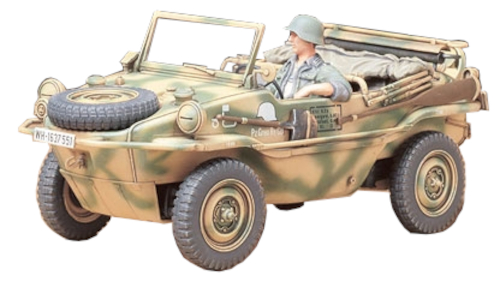
Our Price: $19.49
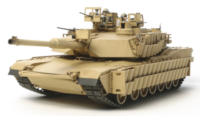
TAMIYA 1/35 US M1A2 Sep Abrams Tusk II Tank
Description:
During the 2003 Invasion of Iraq, the U.S. deployed its latest M1A2 Abrams main battle tanks and these continued to be used in Iraq during the subsequent occupation period. Due to the threats posed by RPGs and improvised explosive devices (IEDs) in the urban environments, the tanks were upgraded with more protection in the form of Tank Urban Survival Kits (TUSK I) in 2004. The upgrade included features such as reactive armor on the hull sides, hull underside armor to protect against land mines, an M2 machine gun mounted above the main gun barrel, infrared cameras for the crew, and an external telephone for communication with accompanying infantry. A further development called TUSK II added features such as tile-shaped reactive armor to the turret and hull sides, armored shield for the commander, and a rear-view camera. The TUSK kits could be installed in field depots in about 12 hours and different tanks had different features equipped. TUSK kits could only be installed in theatre due to the reactive armor.
The Tamiya 1/35 scale model uses new data gathered to ensure it is the best M1A1 kit in the model world.

Our Price: $85.99
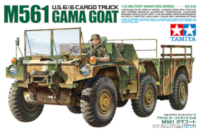
TAMIYA 1/35 6X6 M561 Gama Goat
Description:
Originally commissioned in 1966 as an off-road, amphibious vehicle, the M561 Gama Goat was a 6-wheel drive truck consisting of a 4-wheel tractor and a 2-wheel carrier module. What really set it apart from other vehicles of its type, however, was its employment of an articulation joint between the two modules that allowed them to move independently of one another: a most useful skill when traversing rough terrain. The 14,000 Gama Goats produced up to 1973 were used in a variety of roles by both the U.S. Army and Marine Corps, and were deployed in the fighting in Grenada in 1983, although by the start of the 1990s the Gama Goat had been largely phased out. The former half of its unusual nickname came from Roger Gamaunt, designer of the key articulation joint, and the latter half from its tenacious goat-like climbing ability.
1/35 scale plastic model assembly kit of the M561 Gama Goat.
★Length: 170mm, Width: 62mm.
★The model accurately captures the unique and powerful 2-module form of the M561.
★Articulation joint is recreated using a poly cap and provides authentic movement.
★Includes optional front windscreen and winch parts.
★Realistic depiction of the complex 6-wheel suspension is achieved with uncomplicated assembly.
★Comes with 1 figure and 3 marking options.

Our Price: $44.99
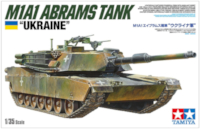
TAMIYA 1/35 M1A1 Abrams Ukraine
Description:
Veteran Warrior
The M1A1 Abrams was adopted by U.S. forces in August 1984, and while it was originally equipped with a rifled 105mm gun, a later upgrade to a 120mm smoothbore piece significantly improved its offensive capabilities. Also given a precision fire control system and a 1,500hp gas turbine engine, when the M1A1 was fielded in the Gulf War in 1991, it proved more than a match for enemy T-72 tanks. It has remained in service with timely upgrades over the years, and in January 2023 the U.S. announced it would send around thirty M1A1’s to Ukraine. This LIMITED EDITION assembly kit release come with all new box art and decals.
About the Model
★This is a 1/35 scale plastic model assembly kit. Length: 300mm, width: 105mm.
★The M1A1 form is captured faithfully, with depictions of the flat armor surfaces and the 120mm smoothbore gun. ★Engine room grilles and armor weld lines add a further layer of detail to the model.
★Features belt-type depictions of tracks.
★Nylon mesh is included for recreation of turret rack cover.
★Markings for tanks provided to Ukraine are included.

Our Price: $30.99
- Page 8 of 9 | 98 Total Products